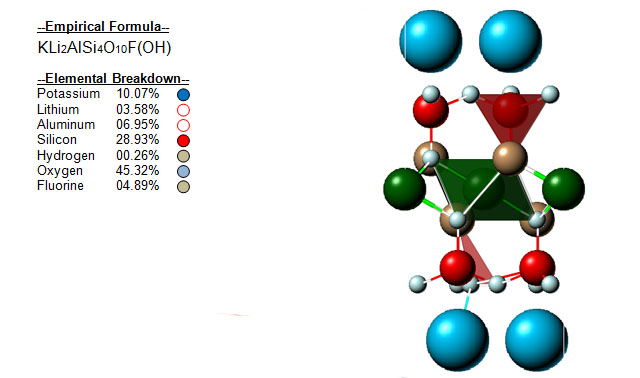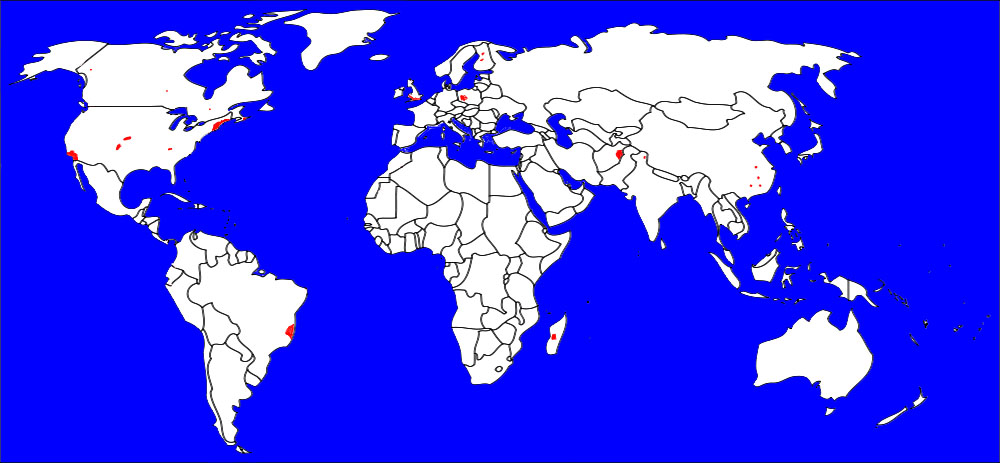

| Mineral Name | Lepidolite |
| First Discovered | 1792 |
| Nickel-Strunz Classification | 09.EC.20 |
| Dana Classification | 71.02.02b.07 |
| ICSD | Pre IMA |
| Mineral Group | Silicates |


| Cleavage | Perfect |
| Colour(s) | Colourless, Gray white, Lilac, Yellowish white |
| Specific Gravity | 2.84 |
| Diaphaneity | Translucent |
| Fracture | Uneven – flat surfaces fractured in an uneven pattern |
| Mohs Hardness | 2.5 to 3.0 |
| Luminescence | Non-fluorescent |
| Luster | Vitreous to Pearly |
| Streak | White |
| Habit(s) | Crystalline to Disseminated to Massive |
| Radioactivity | Lepidolite per GRapi unit = 143.68 |
| Magnetism | Non-magnetic |

The following health hazards should be noted when handling lepidolite
 |
RADIOACTIVE Slightly detectable radioactivity |

The following image shows the elemental breakdown of the mineral lepidolite along with the mineral crystal structure.


| Crystal System | Monoclinic |  |
| Class | Group C | |
| Axial Ratios | a : b : c = 0.5808 : 1 : 2.2474 | |
| Tenacity | Elastic | |
| Optical Data Type | Biaxial (-) | |
| Pleochroism (x) | Colourless | |
| Pleochroism (y) | Colourless | |
| Surface Relief | High | |
| Dispersion | Weak r > v |

Lepidolite can be referenced in certain current and historical texts under the following seven names:
The mineral lepidolite can be translated into the following select languages:
| Arabic | اللبيدوليت | Bulgarian | Chinese (Sim) | 锂云母 | |
| Croatian | lepidolit | Czech | Lepidolit | Danish | |
| Dutch | Lepidoliet | Esperanto | Estonian | ||
| Finnish | Lepidoliitti | French | German | Lepidolit | |
| Greek | Hebrew | Hungarian | Lepidolit | ||
| Italian | Japanese | リチア雲母 | Korean | 레삐 | |
| Latin | Lithuanian | Norwegian | |||
| Persian | لپدولیت | Polish | Lepidolit | Portuguese | |
| Romanian | Russian | Лепидолит | Slovak | Lepidolit | |
| Spanish | Lepidolita | Swedish | lepidolit | Tagalog | |
| Turkish | Lepidolit | Ukrainian | лепідоліт | Vietnamese |

Lepidolite can be found in a few places around the world. The map below shows major documented concentrations of lepidolite:


 |
The MIROFOSS database offers free printable geological identification tags for personal and non-profit use. These tags can be used to properly identify mineral samples in your collection. -Click here- to download a full size jpeg image for a lepidolite identification tag; which can be printed on paper or used with a plastic laser printer. |
 |
What's this? What can I do with it? |

| Chemical Composition | Stevens, Rollin Elbert (1938), New analyses of lepidolites and their interpretation: American Mineralogist: 23: 607-628. Kogure, T. and Bunno, M. (2004) Investigation of polytypes in lepidolite using electron back-scattered diffraction. American Mineralogist: 89: 1680-1684. |
| Crystallography | Schaller, Waldemar Theodore (1905), Crystallography of lepidolite: American Journal of Science, 4th. Series: 19: 225-226 |
| History | Canadian Mineralogist (1998): 36: 905-912 Mineralogical Magazine (1999): 63: 267-279 |
| Geographical Data | Mindat.org. Retrieved on 2012-03-15 |
| Physical Identification | Webmineral.com. Retrieved on 2012-03-15. |
| March 15, 2012 | The last time this page was updated |
| ©2017 MIROFOSS™ Foundation | |
 |